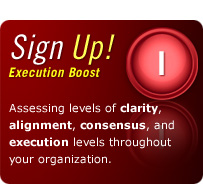Self-Mastery Tip: Make Good Physical Health Practical
January 7th, 2010
Almost everyone knows that taking care of our bodies is important to enhanced influence over our thoughts, feelings and behaviors. Promoting improved health in the major systems of the body (including the cardiovascular, muscular-skeletal, nervous, endocrine and respiratory system) can enhance energy, increase positive moods and decrease the frequency and intensity of illnesses, unnecessary conflict and pessimism.
All of this begs a critical question: If there is so much positive pay-off for better physical health that people are clearly aware of, why is it that so many of us do not engage in activities that can bring them about? We’ve found that two major reasons why people do not attend to their physical health regularly: (1) they do not consistently link good physical health to personal and professional success and satisfaction and (2) they do not put together a plan that is both helpful and practical, which results in either unhelpful routines or routines that are given up on within a few weeks of beginning them.
(1) they do not consistently link good physical health to personal and professional success and satisfaction and (2) they do not put together a plan that is both helpful and practical, which results in either unhelpful routines or routines that are given up on within a few weeks of beginning them.
Better physical health can be made more practical by identifying the following: (a) customized methods of being more healthy, (b) the barriers to engaging in those methods and (c) the most powerful ways to overcome these barriers to action. Here are some ways people have been able to make better physical health practical in their lives:
- Identify 1-2 health-promoting activities that you would like to regularly engage in. The first step to improved health is typically the identification of healthy activities that we genuinely have a certain amount of enjoyment of (or motivation for) engaging in regularly. Many of us do not think about the long haul when beginning to engage in these activities, so motivation and enjoyment are ignored when developing these activities. This is one of the major reasons why new health-promoting activities tend to be given up on only a few days or weeks after they are begun. So, it is important to identify activities that you can imagine being a part of your life for years when making these sorts of plans and to regularly remind ourselves of how important these activities are to our personal and professional lives.
- Identify the top 2-3 barriers to regularly engaging in health-promoting activities. The next step in making good health more practical is often awareness of the blocks to doing so. There are all sorts of barriers to engaging in health-promoting activities, from perception of not enough time to feeling low-energy to lack of enjoyment. Identifying these barriers is a critical step in making a regular health routine practical, but only if we include the next step in this process (the creation of solutions to help overcome barriers). Many of us do not move on to this step, making the identification of barriers a way in which to simply affirm that good health is not practical to us.
- Develop solutions to help overcome barriers to health-promoting activities – and do not stop doing so until you are engaging in these health-promoting activities. As stated in the previous step, the generation of solutions to overcome barriers to healthier living is a critical step in this process. For example, people with time constraints can shorten their work-outs when needed. People with low-energy can select options that do not require high levels of intensity (for example, stretching, walking or eating better) until their energy levels increase. Those who are not having fun with their health-promoting activities can do something to increase their enjoyment (like asking enjoyable others to do the activities with them, listening to music while working out or decreasing the intensity of an activity that is causing too much pain or discomfort). Developing solutions to these sorts of barriers (and committing to never stopping until good solutions are uncovered) also often comes with a positive “side effect:” the cultivation of another aspect of our Self-Mastery model: realistic optimism.
NOTE TO THOSE USING THE MISSION FULFILLMENT SYSTEM: You can work toward making good physical health more practical by adding a new Objective to your system by using the “Add New Item” link (for example, “Develop and execute a practical health-promoting plan”). You can then develop a SMART Goal related to that new Objective by using the “Add Subitem” link to the far right of the new Objective (for example, “Stretch for between 10 and 30 minutes at least 3 times a week, listening to my favorite music when I feel like doing so.”).
FOR THOSE WHO ARE NOT ON THE MISSION FULFILLMENT SYSTEM: Click here to for more information and click here to sign up.
FINAL NOTE: If you were linked to this article by a video or email, please return to that link and proceed with any other instructions that you deem helpful. For more Execution Excellence and Self-Mastery tips and tools visit our site at: www.excellenceuniversity.net
Article Filed under: 1. Self-Mastery Tips



1 Comment Add your own
1. Lindsey | October 4th, 2014 at 10:10 pm
This post discusses something that has such a noticeable effect in my life… the benefit of good physical health. My entire life I have been lucky enough to be involved in many sports, from gymnastics to pole vaulting to dance. Unfortunately, when I fractured my spine, it ended my pole vaulting career and severely limited my range of activities I could engage in. I have always known that when I stop focusing on good physical health, my mental state declines quickly, so it is a big priority to me. However, I had to think of some new things to do after the injury and learn to stick to them. Hoop dancing, which was something I had done already, stepped into the forefront of my exercise (so long as I kept myself upright). Once my back healed, and I had a bit more flexibility, I decided to start doing yoga. Not only was this a great exercise option, but it also had the power to rehabilitate my back. While barriers such as fatigue and time-constraints seemed valid, I realized that putting yoga on my to-do list every day encouraged me to get going. Also, I started by doing short classes, such as 10-15 minutes worth of exercise. I also started a 30 day yoga challenge, which helped motivate me to keep going. Now, my roommate and I do yoga almost every night together, and it really helps us both stay on track. I have realized that I can cater it to my needs too. For example, if I don’t feel well, I do a “chill out/restoration” yoga flow, which is mainly stretching and meditation based. When I feel well, though, I may do a full-body flow or some power yoga. This makes it really hard for me to justify not doing yoga, which is a great thing! Though I may not be engaging in something high intensity, I still reap the benefits; good physical health to benefit the mind!
Trackback this post | Subscribe to comments RSS Feed
Leave a Comment
Some HTML allowed:
<a href="" title=""> <abbr title=""> <acronym title=""> <b> <blockquote cite=""> <cite> <code> <del datetime=""> <em> <i> <q cite=""> <s> <strike> <strong>